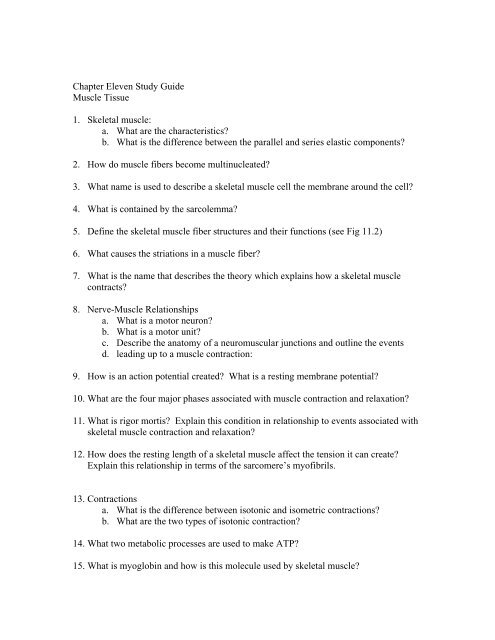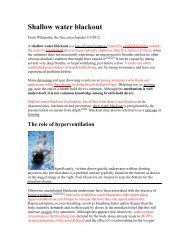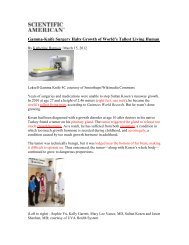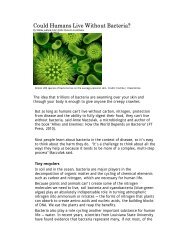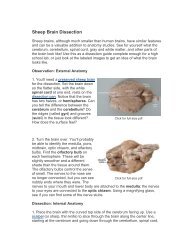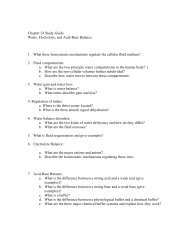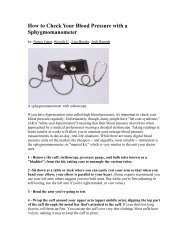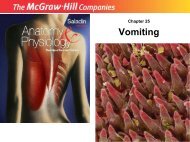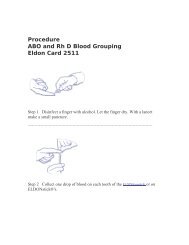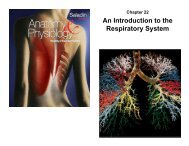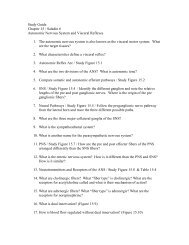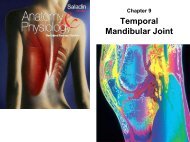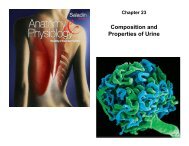Study Guide Chapter 11
Study Guide Chapter 11
Study Guide Chapter 11
- No tags were found...
You also want an ePaper? Increase the reach of your titles
YUMPU automatically turns print PDFs into web optimized ePapers that Google loves.
<strong>Chapter</strong> Eleven <strong>Study</strong> <strong>Guide</strong><br />
Muscle Tissue<br />
1. Skeletal muscle:<br />
a. What are the characteristics?<br />
b. What is the difference between the parallel and series elastic components?<br />
2. How do muscle fibers become multinucleated?<br />
3. What name is used to describe a skeletal muscle cell the membrane around the cell?<br />
4. What is contained by the sarcolemma?<br />
5. Define the skeletal muscle fiber structures and their functions (see Fig <strong>11</strong>.2)<br />
6. What causes the striations in a muscle fiber?<br />
7. What is the name that describes the theory which explains how a skeletal muscle<br />
contracts?<br />
8. Nerve-Muscle Relationships<br />
a. What is a motor neuron?<br />
b. What is a motor unit?<br />
c. Describe the anatomy of a neuromuscular junctions and outline the events<br />
d. leading up to a muscle contraction:<br />
9. How is an action potential created? What is a resting membrane potential?<br />
10. What are the four major phases associated with muscle contraction and relaxation?<br />
<strong>11</strong>. What is rigor mortis? Explain this condition in relationship to events associated with<br />
skeletal muscle contraction and relaxation?<br />
12. How does the resting length of a skeletal muscle affect the tension it can create?<br />
Explain this relationship in terms of the sarcomere’s myofibrils.<br />
13. Contractions<br />
a. What is the difference between isotonic and isometric contractions?<br />
b. What are the two types of isotonic contraction?<br />
14. What two metabolic processes are used to make ATP?<br />
15. What is myoglobin and how is this molecule used by skeletal muscle?
16. What is the phosphagen system? What two enzymes play a role in the phosphagen<br />
system?<br />
17. How does short-term and long-term energy differ?<br />
18. What causes muscle fatigue?<br />
19. How does maximum oxygen uptake influence performance?<br />
20. How do the muscle fibers of a sprinter differ from those of a marathon runner? The<br />
soleus and gastronemius muscles are both plantar flexion muscles. Why would we<br />
“evolve” two muscles with the same action?<br />
21. Are muscles stronger than the bones? Explain<br />
22. What factors determines muscular strength?<br />
23. How is the muscle fiber changed by resistance exercise?<br />
24. How is the muscle fiber changed by endurance exercise?<br />
25. Why is cross training important?<br />
26. Calcium plays a key role in muscle contraction. What muscle type depends only on<br />
the sarcoplasmic reticulum as its source of calcium?<br />
27. How does the sarcoplasm differ between the three muscle types?<br />
28. Be able to outline the steps in excitation-contraction coupling of a skeletal muscle:<br />
29. What is the “broken link” in muscular dystrophy?


